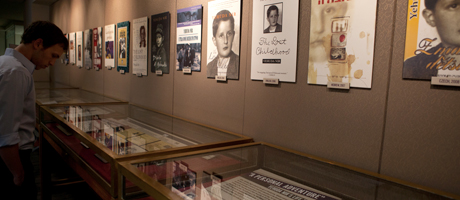By Menachem Wecker
When Bonnie Maslin talks about her husband, Yehuda Nir’s complicated identity, she is not using the term lightly.
Dr. Nir posed as a Catholic Pole to avoid being sent to a concentration camp during World War II, and assumed the identity, along with his mother and sister, of dead Jewish citizens of then-British Mandate Palestine after the war.
In Israel, Dr. Nir took on the name Nir, Hebrew for “plowed field” and a translation of his Germanic name Grunfeld, Dr. Maslin, B.A. ’68, said. Dr. Nir moved to New York in the 1950s.
So her husband was a prosperous Jewish Pole, then a Catholic Pole, then an Israeli and then an American, as well as an accomplished psychiatrist, known particularly for his work on child psychiatry and post traumatic stress disorder, Dr. Maslin said.
“He is a great contributor in all of his identities,” she said.
In addition to authoring the 1989 book The Lost Childhood: A Memoir about his experience as a child survivor of the Holocaust, Dr. Nir has collected books and documents related to World War II over the years. Dr. Maslin started to worry that some day the super would come tell her the basement of the New York apartment building, where the boxes of books were piling up, had flooded.
The basement never flooded, but Dr. Maslin decided to donate more than 1,700 of them to her alma mater, because she said GW was committed to “using the books rather than just relegating them to some dusty storeroom.”
“I bypassed other institutions in favor of GW, because I wanted the books to have an afterlife in the service of learning,” she said.
The books, as well as $25,000 in support that will be donated over the next few years, are part of the Dr. Yehuda Nir and Dr. Bonnie Maslin Special Collection Exhibit Hall at the Estelle and Melvin Gelman Library. Photographs, artifacts and documents of Dr. Nir’s are also on exhibit for the next three months at Gelman Library in a show organized by Dr. Maslin with Hannah Hamill, a master’s candidate in museum studies. Dr. Maslin was on campus for the opening of the exhibit, titled Narrative of a Life: The Identities of Yehuda Nir, last week.
Dr. Maslin, author of four self-help books on dating, marriage and parenting, a psychologist and a former television commentator on psychological matters of more than two decades, studied zoology at GW in the ’60s.
Though she had lost touch with the university somewhat, Dr. Maslin and Dr. Nir are good friends with Walter Reich, Yitzhak Rabin Memorial Professor of International Affairs, Ethics and Human Behavior, and Dr. Nir had been coming to speak to Dr. Reich’s class on Holocaust memory for about 15 years. Dr. Maslin also thought the collection would sit well in the nation’s capital.
At GW, Dr. Maslin experienced a “very warm welcome” from Steven Mandeville-Gamble, associate university librarian for collections and scholarly communication, and “it became clear that GW would be a place that the donation would be used in the service of research and scholarship.”
Sparked by a conversation with Mr. Mandeville-Gamble, Dr. Maslin developed a teaching paradigm that Dr. Reich then used in his class, in which students not only read Dr. Nir’s book, but also split up into four groups to research one of his different identities. Dr. Maslin said she and Dr. Reich find the technique an “unbelievably powerful learning paradigm.” The students describe their project experience as “a transformative experience that has forever changed them,” Dr. Maslin said.
“It gives lie to the thought that libraries are not vital forces of learning,” she said. “I hope that other disciplines will connect their students with the Gelman Library in this intimate and personalized way.”
“The best thing that you could ever hope for is a transformative experience,” she added. “In the most profound way possible, there has been a big bang for these bucks.”
Dr. Maslin also found the students in Dr. Reich’s class to be “the most articulate, emotionally sensitive group that one could imagine.”
“They were just amazing, uplifting and heartening,” she added. “It is a real credit to GW and to Walter Reich for creating this class.”
Dr. Maslin’s and Dr. Nir’s connections to GW extend beyond their friendship with Dr. Reich, Dr. Maslin said. Their daughter, Sarah Maslin Nir, studied at GW before transferring to Columbia University. Sarah views her experience writing for the Hatchet, where she authored a column called Vexed in the City, as a “stepping stone” that led her to her current job as a reporter for the New York Times, Dr. Maslin said.
Asked if there are ways other alumni and friends can help out, Dr. Maslin says contributions of documents and books to the collection are encouraged. “We hope this is the start of something bigger,” she said. “We hope that this gesture will inspire other alumni.”


